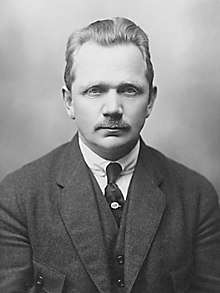Niels Bukh
Niels Ebbesen Mortensen Bukh (15 June 1880 – 7 July 1950)[1] was a Danish gymnast and educator who founded the first athletic folk high school in Ollerup in Funen, Denmark. He achieved international fame as a gymnastics trainer for the Danish team at the Olympic Games in Stockholm in 1912. He was inspired by the rhythmic female gymnastics of the Finnish gymnastics educator Elli Björkstén(1870–1947) and the medical gymnastics of Kaare Theilmann.

Primitive gymnastics
Within the tradition of Pehr Henrik Ling, Bukh developed his own primitive gymnastics, aimed at using forceful exercises to prevent stiffness and bad bodily habits. His 1924 book "Grundgymnastik eller primitiv gymnastik" (known in English as Primary Gymnastics[2] or Primitive Gymnastics[3]) was a how-to manual about his method, which was later adopted by organizations such as the YMCA. Historian Mark Singleton has argued that through the YMCA and their gymnastics training in British India, Bukh's exercises influenced Tirumalai Krishnamacharya's style of asanas in modern yoga as exercise.[4][5][6] In 1931 his gymnastics team toured the world, visiting Japan where his system became highly influential.
National Socialism and homosexuality
His system of exercise became highly popular in Germany, and in 1933 Bukh publicly expressed his allegiance to the National Socialist cause and its aim of improving the health of the Aryan race through gymnastics. This made Bukh unpopular in Denmark, especially after the German occupation of Denmark in 1940. Bukh's support for Nazism caused a backlash when a previous lover publicly revealed Bukh's homosexuality. Bukh had lived together with a male partner for several years, and his sexuality was well known in his family and among his friends and students. Biographers speculate that Bukh never became aware of the Nazi stance against homosexuality, even with his frequent visits to Germany during the 1930s and 1940s. [7][8][9]
Manor house
In 1944 he bought Løgismose manor, which he sold again in 1947.[9]
See also
References
- Niels Ebbesen Mortensen Bukh. gravsted.dk
- Bukh, Niels Ebbesen (1939). Primary Gymnastics. London: Worldcat. OCLC 877612758.
- Singleton, Mark (4 February 2011). "The Ancient & Modern Roots of Yoga". Yoga Journal.
- Not as Old as You Think. OPEN Magazine (12 February 2011). Retrieved on 23 July 2018.
- Goldberg, Michelle (2016). The Goddess Pose: The Audacious Life of Indra Devi, the Woman Who Helped Bring Yoga to the West. Hachette UK. ISBN 0307477444
- Let's Call it Danish Gymnastics: The Yoga Body – Mere Orthodoxy | Christianity, Politics, and Culture. Mere Orthodoxy (23 August 2011). Retrieved on 23 July 2018.
- Bonde, Hans (14 December 2001). Ikaros fra Ollerup. politiken.dk
- Bonde, Hans (6 November 2000). Krop og karisma (in Danish). udd.uvm.dk
- Niels Bukh. Great Danish Encyclopedia (26 May 2010).
External links
| Wikimedia Commons has media related to Niels Bukh. |